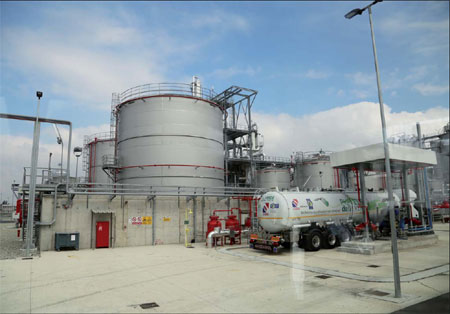

Experts say the second-generation plant in China will pave the way for more green and renewable energy developments. Tuo Yannan / China Daily

Italian firm plans to build world's largest cellulosic ethanol plant in China
Commercial manufacture of cellulosic bioethanol from agricultural residue is expected to be given further impetus after commercial production begins in China next year, experts say.
Chemicals firm Chemtex Engineering Co said work on a new plant, that uses second-generation production technologies, will start soon in a southern China location. The company, a part of Mossi Ghisolfi Group of Italy, is a pioneer in the second-generation technologies and has a cellulosic bioethanol plant in Italy.
""We plan to invest $500 million (370 euros) in China for the conversion of one million metric tons of biomass into bio-ethanol and bio-glycols," says Sean Ma, president and chief executive of Chemtex China.
Bioethanol is considered an important green, renewable energy globally, and can be added to petrol as an additive. Bioethanol, petrol blends are commonly used in countries such as the United States and Brazil, and are important in reducing carbon emissions, boosting fuel quality.
Cellulosic biofuels are normally made from biomass such as wood waste, sugarcane and bagasse, a by-product of sugarcane or sorghum production, and are regarded as sustainable alternatives to corn-based ethanol and petroleum-based diesel.
Beta Renewables, a joint venture between Mossi Ghisolfi Group of Italy and biochemical company Novozymes of Denmark, which set up the first cellulosic bioethanol plant in Italy last year, has already indicated that it expects output to rise significantly in the long run.
"We will continue to commercially expand Beta Renewables' core technologies throughout the world, especially in China, as we are confident of the robust global demand," says Guido Ghisolfi, chairman and chief executive.
The Italian factory can produce 75 million liters of cellulosic ethanol a year from agricultural waste, making it the largest in the world. The company says it is also the only one of its kind that can produce bioethanol from agricultural residue and then convert it to energy on a commercial scale using enzymatic conversion. The plant mainly uses wheat straw, rice straw and arundo donax, a cane plant growing in damp soils, to produce ethanol.
Ma says the selection of the plant location is based on adequate feedstock supplies and a ready collection system. The investment would be the biggest bioethanol investment by an overseas company in China, he says.
There are two kinds of technology for making bioethanol, the first generation involving crop cultivation, which is widely used in China, and the second generation that uses agricultural residue, Ma says.
"Normally in China, first-generation bioethanol is made from crops, such as corn and cassava," says Zhao Xiangdong, the consul for science, technology, education and culture at the Chinese Consulate General in Milan.
China has seven big bioethanol facilities, and four of them, including Jilin Ethanol Co and Henan Tianguan, use first generation technology or grains as feedstock, says Michael Christiansen, president of Novozymes China.
Two factories use the 1.5-generation technology or cassava and sweet sorghum for fuel output, while only one factory, Shandong Longlive, uses corn-cob residue or second-generation technology.
China is focusing more on second-generation bioethanol technology to avoid competition between humans and bioethanol manufacturers, Zhao says.
China has set up a comprehensive and complete legal framework for the development of biofuels. The Renewable Energy Law encourages the use of renewable energies, while the 12th Five-year Plan (2011-15) has envisaged a production of 4 million tons of bioethanol by 2015.
The country has also taken many supportive measures such as financial incentives for further developing bioenergy and biochemical industries.
However, compared with the US and Brazil, only 3 percent of China's petrol consumption has been replaced by ethanol fuels. Though the numbers are still small, China is the third largest adaptor of ethanol in the world after the US and Brazil.

The International Monetary Fund says there were 760 million cars across the world in 2010. By 2015, the figure is expected to reach 2.9 billion, with the bulk of the increases coming from countries like China.
Although China is the world's fifth largest oil producer, it has also been a net oil importer since 1993. In 2011, it imported more than 5 million barrels of crude a day, and accounted for 54 percent of the total demand.
Zhao of the Chinese consulate in Milan says that the government is committed to encourage the 1.5 and second-generation technologies to encourage the shift to non-food feedstock ethanol production.
Bloomberg New Energy Finance says that by 2030, 914 million tons of agricultural residues will be available in eight selected regions globally and can replace half of the global petrol requirements. In China 221 million tons of biomass including wheat, corn and rice residue will be available during the same period, making it the largest biomass producer in the world.
The second-generation plant in Anhui province will also pave the way for more green and renewable energy developments, Zhao says.
Non-grain biofuel progress is important for China, as it has to keep up with its emission goals and because of the caps on food-based biofuels, experts say. China now produces about 1.8 million tons of ethanol a year, accounting for just 2 percent of total petrol demand.
Some provinces like Shandong and Henan have started blending 10 percent ethanol with petrol in pilot projects. However, many problems hamper further development.
In theory, one can produce 337 kg ethanol from 1 ton of corn straw, but it largely depends on the transfer potential of the enzyme used. Enzymes account for the bulk of the production costs, and most of the cutting-edge technologies are still unavailable in China.
Another problem is cost-effectiveness. Mixing 10 percent ethanol with petrol leads to overall cost savings of just 2 percent, thereby indicating the need for further cuts in bioethanol production costs. Similarly it is difficult for first-generation plants to make a smooth transition to second-generation technology.
tuoyannan@chinadaily.com.cn
(China Daily European Weekly 11/15/2013 page20)









